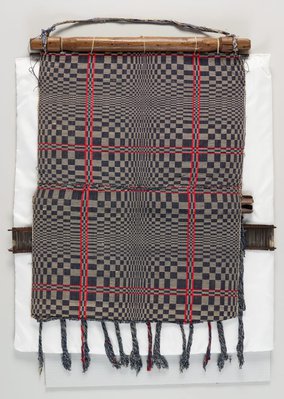-
Details
- Other Title
- On the loom textile
- Place where the work was made
-
Abra
→
Central Cordillera
→
Luzon
→
Philippines
- Cultural origin
- Itneg
- Date
- 20th century
- Media category
- Textile
- Materials used
- wood, cotton; plain weave
- Dimensions
- 88.0 x 70.5 cm
- Credit
- Gift of Dr John Yu and Dr George Soutter 2005
- Location
- Not on display
- Accession number
- 197.2005
- Copyright
- Artist information
-
Itneg
Works in the collection
- Share
-
-
About
The mountainous region of Central Cordillera in northern Luzon is home to a large number of indigenous communities. Their fierce self-determination and geographic isolation provided relative protection from the cultural influences of Spanish colonisation. However, their art did not remain unchanged. Communities retained forms which were useful and meaningful, abandoned others and created new forms to meet new purposes – a tradition that has continued into 21st century.
In Central Cordillera art is part of everyday life and is intrinsically linked to community and spiritual wellbeing. Many villages are built around a central stone platform where social and spiritual rites are performed. These include the worship of deities and ancestors and the consecration of sculptural figures.
The carving of ancestral and religious figures, while today most prevalent among Ifugao men, was previously a practise shared by all communities of the Central Cordilleran mountain range. Textiles, on the other hand, are woven exclusively by women using backstrap looms. There has been a long and active trade in locally woven products, so many communities share techniques and an appreciation for similar motifs and colour schemes.
This is a backstrap loom with a section of unfinished owes cloth. When backstrap looms are used, the weaver’s body acts as an anchor point. Usually one end of the loom is tied to a tree or a house beam and then a strap at the other end is stretched around the body of the weaver to create tension. This enables the weaver to thread the horizontal (weft) threads through and in-between the vertical (warp) threads. The highly optical patterning of this cloth is achieved by a continuous supplementary weft technique known as pinilian. The design itself is known as kusikos. It illustrates the constant movement of the whirlpools and whirlwinds that are intended to distract and pacify the wind god.
-
Exhibition history
Shown in 1 exhibition
Passion and procession: art of the Philippines, Art Gallery of New South Wales, Sydney, 24 Jun 2017–07 Jan 2018
-
Provenance
John Yu, 1970s-2005, Sydney/New South Wales/Australia, purchased mid-1970s from an antique shop on Mabini st., Manila, Philippines. Donated to the Art Gallery of New South Wales, Sydney, 2005.


